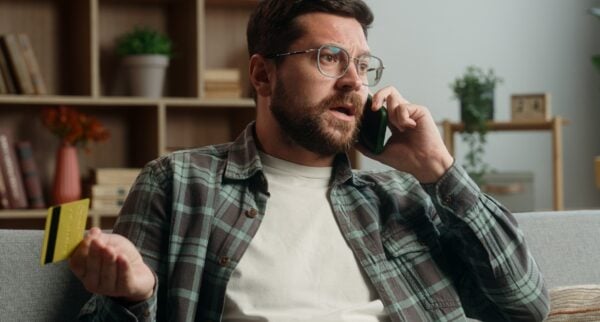It can be awkward and sometimes stressful, having your credit card declined, though it really depends on the situation. If you’re buying a bottle of soda at a convenience store and have to leave empty handed, there are worse things that could happen. On the other hand, if you are at the grocery store with a full cart or in line at the movies with your kids, it’s another story.
Having your credit card declined is practically a rite of passage for many people. It’s hard to imagine that anyone can go through life without their credit card or debit card being declined at least once, even if it’s just a technical snafu.
The last thing you should do is panic or beat yourself up over it. Instead, it’s important to figure out why it happened in the first place, and what to do about it if you find yourself in this uncomfortable situation.
Why was my credit card declined?
There are a number of reasons your credit card might be decline. Here are some common culprits:
- You’ve reached your credit limit
- Your credit card company suspects your card has been stolen
- You gave the retailer the wrong credit card information
- Your credit card hasn’t been activated
- You were buying cryptocurrency with your credit card
- Your card has expired
- Your credit limit was lowered
- Addresses don’t match
- Your credit card is broken
- Your credit card account was closed
There could be other minor reasons, too, why your credit card might not be accepted. For instance, the card reader may not be working properly. That’s a common reason why somebody’s credit card is declined when they have money left to spend. That’s also an easy problem to fix. Fixing the reasons above can sometimes be a little more complicated, so let’s cover what to do if you find yourself in one of these situations.
What to do if your credit card is declined
You have reached your credit limit
You’ve maxed out your credit card. This is the least fun scenario. This means that whatever your credit limit is, what you want to buy will put you over that, if you aren’t already there.
How to fix it: In the moment, hopefully you have another credit card or debit card or wad of cash that you can use to pay for your merchandise or service. Longer-term, you’ll need to make a payment and bring your available credit level down. You also might want to ask your credit card issuer for a higher credit limit, and you may have a good chance of that if you’ve been a responsible cardholder.
Your credit card company suspects your card has been stolen
This could happen when you travel, or if you make a large purchase with your card. Credit card issuers take fraud seriously, and declining your credit card when your spending looks different is an easy way to protect you. If the purchase was you, this is an easy problem to fix. And if it wasn’t you, well, in that case it’s probably best that the card was declined.
How to fix it: Contact your credit card company and explain what happened. Incidentally, some credit cards allow you, before you go on vacation, to alert them when you’ll be gone. That’s a useful way of making sure your credit card isn’t declined on a trip.
Also, be sure to customize your credit card alerts. Instead of getting outright declined, you could instead receive a text, call, or email from your credit card issuer asking you to authorize a purchase. Then you simply must approve or deny the charge, instead of dealing with the hassle of having your card declined.
You gave the retailer the wrong credit card information
When shopping online it’s easy to accidentally type your card number wrong, or perhaps enter the wrong security code. Thankfully, this is an easy one to fix.
How to fix it: Simple! Double check your information and make sure you’ve inputted it correctly.
Your credit card hasn’t been activated
When you receive a new credit card you must activate it before you can use it. If you try to use it before its activated, your card could be declined.
How to fix it: Contact your credit card issuer for assistance or go to your issuer’s website and follow the card activation instructions. Usually all the information for activating a new card comes printed on a sticker that’s attached to your card, or the information is in your welcome packet. Credit card issuers these day make card activation a cinch, though getting a new credit card can be exciting, so it’s easy to understand this step sometimes getting missed.
You were buying cryptocurrency with your credit card
Many card issuers won’t allow you to buy cryptocurrency with a credit card. It’s possible with some cards, but currently, most issuers don’t allow this.
You also probably don’t really want to buy cryptocurrency with your credit card. Because it’s money, buying crypto is often treated like taking out a credit card cash advance, and so you may wind up with a cash advance fee. There may be other fees involved, too, so you really want to pay for crypto with a credit card carefully.
How to fix it: If your credit card was declined buying crypto, you may just want to purchase it with your debit card. There are a few credit cards out there that offer crypto rewards, but they’ve declined in popularity as crypto has experienced some bumps in the road.
Your card has expired
Receive an email saying your payment wasn’t successful for a service such as Netflix, even though you’ve been streaming things for months without any prior problems? There’s a good chance that the credit card you have on file has expired. It’s harder to overlook your card’s expiration date when you swipe it at the register, but much easier to do when it’s largely used for things like autopay.
How to fix it: Credit card issuers are generally pretty good about sending a replacement card a few weeks before your card expires. Check your mail. Perhaps your new card is sitting on your desk in an unopened envelope. If you accidentally tossed your new card, or you never received one, contact your credit card issuer. Additionally, if you use your card for autopay, keep an eye out for alerts from your service providers. Oftentimes you’ll receive an email letting you know your card on file is set to expire soon.
Your credit limit was lowered
And you missed the memo. (Seriously, your credit card probably sent you an email or letter or both, and you never read it.) Or maybe there was no memo to miss. Sometimes credit cards will lower the credit limit or close the account without telling you (but usually that’s if you haven’t used the card in a long time or you’ve somehow broken the terms of your card agreement).
How to fix it: Contact your credit card issuer and ask them if they can raise your credit limit. And, of course, pay off your credit card, so you have more available credit and so you aren’t paying interest on your debt.
Addresses don’t match
If you’ve moved recently and forgot to update your credit card account with your new information, and then you entered your new address in the billing address field when making an online purchase, your card could be declined. It’s unlikely you’ll run into issues in a store, but if you shop online regularly, this is an important thing to correct.
How to fix it: Another easy one. Check your card account details and make sure your address is up to date.
Your credit card is broken
As unlikely as it seems, magnetic strips wear out. Chips sometimes don’t work. Generally, rather than being declined, of course, you’re just not going to be able to make a payment. But, still, we’d be remiss to not mention that the problem may not be with you and your available credit but the actual card itself. If you know you have money in your account and keep wondering, “Why does my credit card keep getting declined?,” a broken chip or strip could be the reason.
How to fix it: Short term, ask the clerk to manually enter your credit card number. Then call your credit card company and ask for a replacement card.
Your credit card account was closed
Perhaps you paid off your card, put it in a drawer, forgot about it for a couple years, and then found it one day and decided to put it to use again only to find it was declined despite not having yet reached its expiration date. After an extended period of inactivity (usually two years) credit card issuers will usually automatically close an inactive account.
How to fix it: Keeping a paid-off credit card account open can be a good idea as it can help your credit score, but it’s important to put a charge on it every now in then, even if it’s only minimal, in order to keep the account active. An easy way to do this is to use the card for an automatic monthly payment. Even if it’s just a small one.
Final thoughts
As you know by now, there are a number of reasons your credit card may be declined. Whatever reason you find your card being declined, if you find yourself in this situation, remember these quick tips:
Don’t panic and be polite. This might seem like fairly obvious advice, but it’s easy to forget when you have a line of people behind you who probably have a good idea why you’re not moving along. If you scream, cry, berate the store clerk or the financial gods above and in general have a meltdown, there’s a good chance that shoppers and going to pull out their phones and you’re going to go viral on TikTok. Remaining calm is likely a better bet.
Re-swipe your credit card. If you know that your card shouldn’t have been declined, (i.e., you know you have the funds in your bank account or the available credit on your card), ask the cashier to run your card again or maybe to punch in the numbers instead of you sticking the card into the reader or swiping it. Sometimes there are glitches that can cause a card to be declined and after another attempt, it goes through just fine.
Pick a different payment method. If you have some other way to pay, you can take care of your tab and get out of there. When you get home, check with the card company or your bank to figure out what went wrong.
Take the walk of shame. If there’s no other way to pay, and you are able to leave the store embarrassed but empty-handed, do just that. You’re far from the first person that this has happened to. Just get out of the store, take a few deep breaths, and call the credit card company to see what happened.
Offer your ID or collateral until you return. Did you eat a meal, get an oil change done, or receive some other service before paying and then find your card being declined at the register? If you don’t have another way to pay, here’s the moment where you offer your identification and ask if you can settle up later. This might be even more embarrassing, and it may not fly with every store manager or business owner, but at this point, you may not have many options. If the service provider won’t accept this, consider calling a friend or family member for help. Oftentimes, payments can be made over the phone, and then you can reimburse your rescuer once you figure out what went wrong with your card.
Call your bank or card issuer. After you’ve made arrangements for payment, call the card issuer or your bank to find out why your card was declined. If you’ve already checked your balances and can’t figure out what went wrong, the credit card issuer should be able to clear it up for you with a phone call, and can hopefully set you up to avoid something like this happening again in the future.


